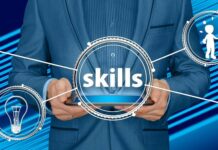Are you interested in creating educational content that truly resonates with your audience? An essential skill in today's digital age, crafting quality educational content can shape minds, drive engagement, and pave the way for enlightened conversations.
This article offers an insider's look at the eight best practices in this essential field. It's a journey through tried-and-true methods, innovative approaches, and the secret ingredients that make learning effective and enjoyable.
Are you ready to change the way you think about education? Let's dive in and uncover the secrets of creating high-impact educational content.
Mastering the Art of Crafting Instructional Material: The 8 Cardinal Practices
In today's information-saturated world, the ability to create effective and engaging instructional material is a vital skill. As we embark on our journey of discovery, let's unearth the eight essential practices that can guide you in moulding instructional resources that deliver knowledge and engage, inspire, and motivate learners.
Venturing Into the Landscape of Learner Profiles
The first step towards creating an impactful learning environment is understanding your audience. The better you know your learners, the better you can tailor your materials to their needs and preferences, and the more meaningful your content becomes. Here's what you need to keep in mind:
Identifying Your Learners
- Demographics: Get to know your learners' age, cultural backgrounds, and geographical locations. These elements can influence their perspective and the context within which they absorb new information.
- Educational Background: Understand their previous educational experiences. This will help you pitch your instruction materials at the right level, ensuring it's not too basic or too advanced.
- Goals and Motivations: Identity what drives your learners. Is it professional development, personal interest, or academic progression? Align your materials with their plans to maintain engagement.
- Learning Barriers: Understand the challenges your learners may face in the learning process, such as language barriers, time constraints, or a lack of prerequisite knowledge. Addressing these issues in your content creates a more inclusive learning environment.
Comprehending the Learning Styles Spectrum
- Visual Learners: These learners respond best to visual information, like diagrams, graphs, or infographics.
- Auditory Learners: For these learners, listening to information works best. They benefit from podcasts, verbal explanations, and musical cues.
- Reading/Writing Learners: These learners prefer to absorb information through reading and note-taking. They respond well to text-based content.
- Kinesthetic Learners: These hands-on learners learn best by doing. Interactive exercises, real-world tasks, and physical activities are efficient for them.
- Multimodal Learners: Lastly, we have learners who combine the above styles. A mix of content formats would work best for this group.
The Cornerstone of Effective Instruction: Clear, Measurable Learning Objectives
Once we fully understand our audience, we focus on establishing learning goals. Clear, measurable learning objectives serve as the foundation for effective instruction. Here's why they're so essential:
Importance of Clear, Measurable Learning Objectives
- Purposeful Learning: Clear learning objectives guide the learning journey, helping learners understand why they are learning what they're learning.
- Guide for Instructional Design: Learning objectives shape the design of your instructional materials, helping you choose the right content, activities, and assessments.
- Measurement of Success: With measurable objectives, you can assess the effectiveness of your instructional material and your learners' progress.
- Motivation and Engagement: Well-defined goals can increase learners' motivation and engagement, as they understand what they're working towards and can see their progress.
The Art and Science of Formulating Learning Goals
Formulating practical learning goals isn't a matter of chance. It's a thoughtful process that requires a clear understanding of what you want your learners to achieve. Here's a roadmap to guide you:
How to Formulate Effective Learning Goals?
- Specific: the goals should clearly define what the learner is expected to know or be able to do.
- Measurable: the objectives should be quantifiable or observable to determine when they have been achieved.
- Attainable: ensure the learning goals are realistic, given the learners' background knowledge, abilities, and available time.
- Relevant: the goals should align with the learners' needs, interests, and broader learning path.
- Time-bound: specify when learners should be able to achieve the objectives to provide a clear timeline for progress.
An Excursion Into the Diverse Landscape of Content Formats
Now that we have the learners and goals defined, it's time to focus on how we deliver our information. Varying the format of your content can significantly enhance engagement and cater to different learning styles. Let's look at the various forms and their pros and cons.
Pros and Cons of Different Formats: Text, Video, Audio, Infographics
- Text: The beauty of text lies in its simplicity. It's easily accessible, can be consumed at one's own pace, and is excellent for in-depth explanations. However, relying solely on text can make the learning experience monotonous and be a deterrent for visual or auditory learners.
- Video: Videos offer dynamic, visual, and auditory learning experiences. They can help simplify complex concepts through visuals, animations, and real-life demonstrations. But, high-quality videos can be time-consuming and costly, and learners might require a good internet connection for streaming.
- Audio: Audio content like podcasts is perfect for multitasking learners, allowing them to learn while commuting or doing chores. However, they lack visual cues and might not be suitable for topics that require visual explanations.
- Infographics: Infographics are a compelling way to present data and processes visually, making complex information easily digestible. But, creating high-quality infographics can require more time and design skills.
The Symphony of Mixed Media: Enhancing Learning Through Variety
The key to delivering an engaging learning experience lies not in choosing one format over another but in the harmony of their combination. Here are some best practices for using mixed media to enhance learning.
Best Practices in Using Mixed Media for Enhanced Learning
- Align Format With Content: Choose the format that best supports the content. For example, use videos to demonstrate processes, text for detailed explanations, and infographics for visualizing data or concepts.
- Cater to Different Learning Styles: Remember our diverse audience? Balance different formats to cater to various learning styles—visual, auditory, reading/writing, and kinesthetic.
- Maintain Balance: While variety is good, avoid overwhelming learners with too many formats in one lesson. Keep it balanced and ensure each design adds value to the learning experience.
- Accessibility: Ensure all learners can access your content. This means providing transcripts for audio and video content, alternative text for images, and so on.
The Power of Participation: The Upsides of Interactive Content
We've talked about the value of a variety of content formats. Now let's enhance this mix even further by incorporating interactive elements. Interactive content fosters an engaging, active learning environment where learners aren't just passive recipients of information but active participants in the learning process. Here's why interactive content matters:
Benefits of Interactive Content in Learning
- Enhanced Engagement: Interactive content encourages learners to participate actively, increasing their engagement and attention levels.
- Improved Retention: Learners interacting with the material are more likely to remember the information, improving knowledge retention.
- Instant Feedback: Interactive elements often provide immediate feedback, enabling learners to promptly understand and correct their mistakes.
- Adaptive Learning: Interactive content can be designed to adapt to individual learners' responses, providing a personalized learning experience.
Innovative Participation: Successful Examples of Interactive Content in Education
As we explore the realm of interactive content, let's take inspiration from examples that have effectively used interactivity to enhance the learning experience.
Examples of Successful Interactive Content in Education
- Quizzes and Assessments: These allow learners to test their understanding of the content, provide instant feedback, and make learning fun and engaging.
- Simulations and Virtual Labs: These provide hands-on experiences, allowing learners to experiment and learn from trial and error in a risk-free environment.
- Interactive Videos: Videos where learners can click, drag, or input responses to engage with the content.
- Digital Games: Educational games can make learning enjoyable and interactive while teaching important concepts or skills.
Personalized Pathways: Making Content Relatable to Your Audience
Creating content isn't just about covering all the facts—it's about making those facts resonate with your learners. We must remember that each learner brings unique experiences and perspectives to the learning environment. Hence, our task is to make the content relatable to them. Here's how:
How to Make Content Relatable to Your Audience?
- Connect to Real-World Applications: Provide practical examples that show how the material applies to everyday life. This strategy makes learning feel more applicable and less abstract.
- Use Familiar Concepts: Build upon your learners' knowledge and experiences. This connection can make new information easier to comprehend.
- Personalize the Learning Experience: Customize content to individual learners' interests and backgrounds if possible. This level of personalization can enhance learner engagement and comprehension.
The Magic of Narratives: The Significance of Storytelling in Education
Our next topic takes us into the world of narratives. For centuries, humans have used stories to pass down knowledge from generation to generation. Storytelling in education is no different—it's a powerful tool to make content more engaging and memorable.
Importance of Storytelling in Education
- Creates Interest: stories are inherently engaging. They spark curiosity, making learners more interested in the material.
- Improves Memory: stories are easier to remember than disjointed facts. They provide a context, making the recall of information more accessible.
- Promotes Understanding: by placing information within the framework of a story, complex ideas can become more understandable.
- Encourages Empathy: stories often involve characters and emotions, which can help learners empathize and understand different perspectives.
Also read: Online Education in 2023: Is It Worth It and How to Prepare?
Evaluation as a Tool: The Role of Assessments
Creating effective educational content isn't a one-way street—it requires us to gauge learners' progress and understand where they are in their learning journey. Assessments and feedback mechanisms play a pivotal role in this process. Let's delve into why:
Importance of Evaluations in the Learning Process
- Checks Understanding: Assessments allow you to check if learners have grasped the key concepts, highlighting areas where they might need extra help.
- Motivates Learners: Progress demonstrated through assessments can serve as a motivator, encouraging learners to work harder.
- Guides Teaching Strategies: Assessments provide valuable data, allowing you to modify your teaching strategies to suit your audience's learning needs better.
Building Bridges: Designing Effective Assessments and Feedback Systems
Now that we understand why assessments are necessary, we must explore how to design practical evaluation and feedback mechanisms. Here's a roadmap:
How to Design Effective Assessments and Feedback Systems?
- Align With Learning Goals: Ensure your assessments align with the learning objectives of your content. This alignment helps to measure the intended learning outcomes accurately.
- Diversify Assessment Types: Use a mix of formative (ongoing) and summative (end-point) assessments to gauge learners' comprehension and skill development throughout the learning process.
- Provide Constructive Feedback: Feedback should be timely, specific, and constructive, guiding learners towards improving their performance.
- Leverage Peer-to-Peer Assessments: Encourage learners to give feedback to each other. This strategy not only provides additional perspectives but also promotes critical thinking.
The Power of Insight: Using Learner Data to Improve Content
In this era of digital learning, we have a unique opportunity to leverage data and analytics to enhance our educational offerings. With every click, scroll, and interaction, learners provide invaluable data that can guide us in tailoring our content. Let's take a closer look:
Using Learner Data to Improve Content
- Identify Patterns and Trends: Data analytics can help uncover patterns and trends in learners' behaviour, allowing us better tailor our content to match their needs and preferences.
- Monitor Progress: Regular tracking of learners' progress can highlight areas of difficulty, enabling us to adjust our teaching strategies accordingly.
- Predict Outcomes: With sufficient data, we can anticipate learners' performance and intervene early if necessary, ensuring every learner gets the support they need.
Metrics that Matter: Measuring Engagement and Learning Outcomes
As much as we might wish it to be otherwise, not all learners will respond equally well to the same content. This is where measuring engagement and learning outcomes come in - it allows us to understand what works and what doesn't, helping us continually refine our content.
Significance of Measuring Engagement and Learning Outcomes
- Determine Effectiveness: Engagement metrics (such as time spent on content, completion rates, and interaction levels) can help determine the effectiveness of our content.
- Improve Content: Tracking learning outcomes (such as assessment scores and application of knowledge) helps us understand the impact of our content, guiding improvements.
- Inform Future Strategies: The insights gained from these metrics can inform future strategies, ensuring our content remains relevant and practical.
The Refresh Button: The Importance of Updating Content
As educational content creators, we must be on top of current trends, updates, and changes in our respective fields. It is not enough to produce stellar content; we must ensure it remains relevant over time. Here's why:
Importance of Refreshing and Updating Content
- Maintain Accuracy: With time, information can become outdated. Regular updates ensure that the content remains accurate and reliable.
- Boost Engagement: Updated content keeps learners interested and engaged, reflecting the most current state of affairs in the subject matter.
- Increase Credibility: Regularly updated content helps maintain your credibility as an expert in your field, showing that you are keeping up with industry changes.
Staying Ahead: Tips on Maintaining Content Relevancy
We have established the importance of keeping content up-to-date, but how can we do it effectively? Here are some pointers:
Tips on Maintaining Content Relevancy
- Keep an Eye on Industry Trends: Stay informed about the latest happenings in your field. This way, you can update your content to reflect current trends and developments.
- Regular Reviews: Schedule periodic content reviews. This allows you to identify and update any outdated information proactively.
- Listen to Feedback: Pay attention to comments and feedback from your learners. They may highlight areas in your content that need updating or revising.
- Revisit Learning Goals: As industry standards evolve, learning objectives may need to be revised. Ensure your content continues to meet these changing learning goals.
Tailoring Your Words: Effective Copywriting Tips for Digital Learning Materials
In the digital learning landscape, one's words carry a profound weight in creating a thriving learning environment. How you present information can be the difference between a memorable learning experience and a forgettable one. With that in mind, here are some invaluable copywriting tips for educational materials:
Prioritize Clarity
In writing for digital learning, clarity is paramount—Eschew jargon and complex language may confuse learners. Your words should illuminate the subject, not complicate it.
Embrace Brevity
Ensure your writing is concise and straightforward. With digital learners' typically short attention spans, every sentence should be essential and contribute to the overall learning objective.
Advocate Active Voice
Employ an active voice for a more engaging and direct narrative. For instance, instead of writing "The experiment was performed by the students," opt for "The students experimented."
Fragment Complex Ideas
Break down intricate concepts into smaller, digestible parts. Use subheadings, bullet points, and numbered lists to render your copy more accessible and less intimidating.
Engage Through Storytelling
Stories are memorable and engaging. They can transform an abstract concept into a relatable and compelling narrative. Incorporating storytelling elements in your copy can significantly enhance the learning experience.
Utilize Visual Aids
Supplement your copy with relevant visuals. Images, infographics, or videos can amplify the impact of your words, providing a more comprehensive learning experience.
Interactivity is Key
Interactive elements, such as quizzes or activities, elevate engagement and reinforce learning. Your copy should effectively guide learners through these experiences.
Edit, Proofread, and Polish
Writing is rewriting. Always allot time to revise, proofread, and polish your copy. Seek out ambiguities, redundancies, and grammatical errors that may hinder learning.
Continual Growth: The Cornerstone of Effective Copywriting
Mastering the art of writing compelling copy for digital learning materials is a continual journey. It's essential to stay receptive to feedback, learn from your successes and missteps, and persistently refine your skills.
You can create impactful and engaging educational materials with these guidelines in your copywriting toolkit. Your words are your power; wield them wisely.
The Bottom Line: Mastering the Art of Creating Educational Content
In the ever-evolving world of education, mastering the art of creating educational content is a game-changer. These eight best practices offer comprehensive guidelines that steer you towards crafting content that resonates with your audience and enhances their learning journey.
By understanding your learners, setting clear objectives, and incorporating varied formats, you create an environment conducive to comprehensive learning. Introducing interactive elements, making content relevant, enabling assessments, using data, and ensuring up-to-date content are practices that ensure your materials remain effective and engaging.










